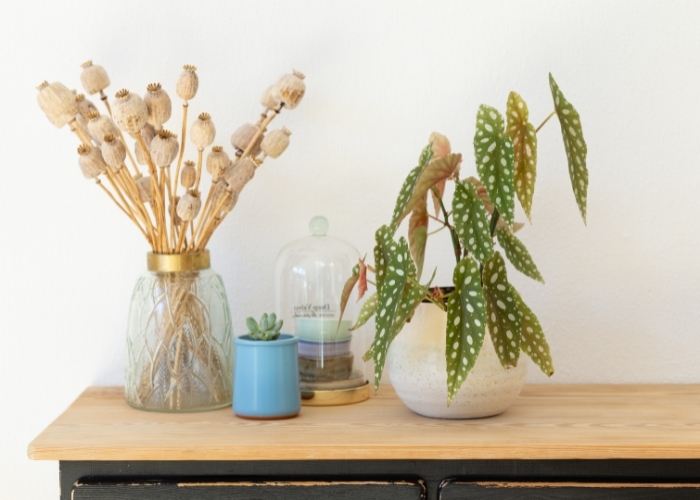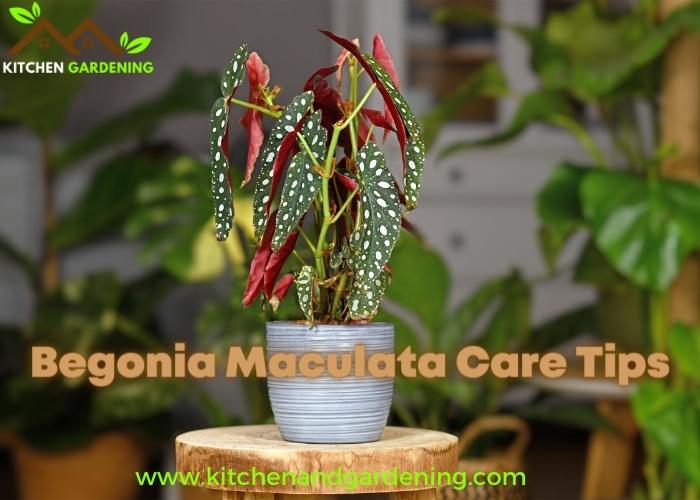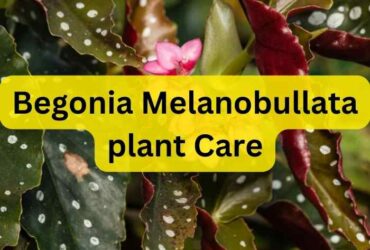There could be many leafy plants in your kitchen garden. Or maybe you like having green plants around you. Therefore, if you are interested in having these types of plants, then you must have been aware of the begonia maculata plant. It is a plant with polka dot leaves. This article revolves around how you can take care of your begonia maculata plant. Let’s dive in for more detail for begonia maculata care.
What Is Begonia Maculata?
Polka dot begonias are named so because of the silver polka dots on their leaves. Most often, Angel Wing spotted Begonias resemble canes since they originate from South America. The four main types of begonias are fibrous, tuberous, canes, and rhizomatous. The leaf has a crimson red underside, and the leaves are olive green. White bell-shaped flowers bloom on the plant after several years. A bamboo-like stem is also present on its branches. These gigantic trees can reach a height of five feet and a width of twenty inches.
People are sure to take notice of this exotic plant. In contrast to an average houseplant, it needs more attention.
Characteristics Of Begonia Maculata
Warm temperatures, filtered solid light, and consistent moisture are essential for these evergreen perennials. They are native to the tropical forests of Brazil, and their cascading white flowers bloom throughout the warm season and grow quickly to three feet or more.
The thick stems of this cane begonia tend to hold moisture, which is why it doesn’t like to be wet. In between waterings, the topsoil on their plants needs to be allowed to dry out a bit.
In addition to light, humidity plays a vital role in begonia maculata care, and steamy conditions characterize its native habitat. The maculata doesn’t need a greenhouse. However, you will need to keep it humid to keep it healthy.
One of the most critical factors is proper potting. In close quarters, they wear out their soil quickly because they like to be somewhat rootbound. Even if it’s just repotting them in the same container, repotting them annually is the best practice.
Pruning and grooming of maculatas are also necessary to keep them looking their best. Propagation is an advantageous characteristic of angelic-winged plants.
Begonia Maculata Care
Following are some points to keep in mind while considering begonia maculata care.
Humidity
In this plant, humidity is the determining factor of success or failure. In addition to not killing them, low relative humidity won’t make them flourish either. Occasionally, increasing ambient moisture can correct leaf loss and flower failure.
No matter whether maculatas are highlighted or not, successful growers keep them humid.
In a dehydrated home, which is usually the case, you need a humidifier. Two primary methods for raising humidity are to group them with other plants and to use water trays. To keep your tropicals healthy, you will have to put in more effort and benefit from it.
If you want high humidity, you should ensure that there is at least 45% humidity. The dry indoor air caused by winter heating makes humidity even more critical during this time of year. So if you are interested in begonia maculata care, do consider this.
Sunlight
Direct sunlight can fade your maculata’s silvery spots or even burn the leaves. Please place it in a bright spot out of strong sunlight. Keeping your windows out of direct sunlight makes them acceptable all year round, as long as they have a southern exposure. The light should be bright and filtered.
Low light is acceptable, but very dim conditions won’t be ideal. If you live in a cold climate, put your polka dot begonia in a bright window with limited direct sunlight.
A maculata that doesn’t get enough light loses colour, turns yellow, and finally sheds its leaves. Getting too much sunlight will result in scorched leaves. Therefore, begonia maculata care includes giving proper sunlight too.
Temperature
The temperature they like is the same as ours, so you’ll have no problem keeping them indoors. Ensure that they are not exposed to drafts and that they do not experience temperatures below 59°F (15°C).
A comfortable temperature for them is 65°F (18°C) to 86°F (30°C) during the day, but they can tolerate higher temperatures during the night. Colder climate residents shouldn’t wait until the first frost before bringing them inside unless they want to free up pot space.
Watering
The wrong type of soil can make watering this spotted begonia difficult, so let’s go over the rules first.
It is best to water Maculatas after the top half-inch of soil has dried out before rewatering, as they like moist soil most of the time. So never water these plants when the ground is wet, or they will develop root rot.
Well-dried topsoil decreases the likelihood of fungus and nuisance pests like gnats. Watering their bottoms is usually recommended – but if that seems silly, if you’re careful, you can avoid getting their leaves wet.
Water thoroughly once the top has dried sufficiently, keeping an eye on the soil. They do not like watering much, but they should not wilt if they take a break between waterings.
Fertilizing
Because it is a flowering plant, Begonia Maculata care includes fertilizer occasionally to maintain its growth. Liquid fertilizer is recommended every other time the plant is watered, and Begonias should be fertilized at least every two weeks according to this ideal. Feed your Begonias only during their growing season. A plant should not be fertilized during the dormant period, which spans autumn (fall) and winter, because this is the time when it needs to rest and recover from the growing season.
Soil Selection For Begonia Maculata
Polka Dot begonia prefers well-draining soil but does not like to be too wet. To give them optimal conditions, mix these modifications:
• Perlite
Volcanic glass, which looks like Styrofoam, is made from tiny balls of white fluffy material. Aeration and light are maintained in the soil and help insulate the soil from rapid temperature changes.
• Wood chips
Wood chips help aerate the soil since their angular shapes create space. Since maculatas are frequently potted and refreshed, decomposition of the chips isn’t a concern.
• Fertilizer
You may want to add some compost or organic fertilizer. Put only a half-handful in each pot, not the recommended amount on the bag. The plant will be fertilized anyway, so this only boosts its fertility.
Repotting The Begonia Maculata

It would help if you repotted your plants once a year at the very least. Small pots suit Maculatas, but their dense root system exhausts the soil. It is still beneficial to rehydrate the ground every year, even if you aren’t potting up.
You will need to loosen the soil around the roots if replanting in the same sized pot. You don’t want them spending too much energy on their root system, so don’t increase the size of your pots too much. The feature isn’t what sets them apart.
Diseases and Pests
Your Maculata won’t be susceptible to diseases or pests if you keep their leaves clean and sterilize your tools. There are mainly fungus and infestations associated with high humidity, and you should not go for one if you are not into begonia maculata care. Following are some diseases that can affect the health of your plant.
Powdery Mildew
Among their most common ailments is this fungal disease. Humidity increases this threat in otherwise healthy conditions. On foliage, circular spots of powdery white covering spread outward.
Treatments can be ineffective, so it’s best to prevent the infestation by removing the affected material and treating it with a fungicide. Be sure to dry the topsoil thoroughly before watering again.
Botrytis
There are soggy, brown splotches caused by botrytis, another fungal disease. Lower leaves that touch the soil are often the first to develop it. Lower leaves that touch the soil are often the first to create it. Pruning affected areas and removing fallen foliage is essential. Apply fungicide if the infection returns after sterilizing with methylated spirits.
Bacterial Leaf Spot
This disease causes leaf spots that look like pimples. Plants that have been heavily infected should be disposed of safely rather than pruned away.
Stem Rot
To prevent this from occurring, the soil must be well-drained and watered carefully. Black, puffy, and mushy stems are the results of the disease.
Pythium Root Rot
A yellowing of roots and a blackening of lower stems are the symptoms of this disease. The proper watering of the soil and sterilization of the soil contribute to its prevention. It is best to discard contaminated plants safely, not to compost them. There is a high level of contagiousness associated with the disease.
Mealybugs And Whiteflies
Unlike beneficial bugs, these pests are not very effective at killing them with pesticides: you’ll kill more than you prevent. Whiteflies hover around when disturbed and live under leaves and stem joints.
Oils and soaps that contain insecticides can be used to treat the problem. Ladybugs and other beneficial predators can also gobble up the pests using a short-acting organic pesticide.
Bottom Line
It is not easy to take care of Begonia maculata, to be completely honest. Begonia maculata care must be taken seriously
In terms of soil, it requires slightly moist soil that should drain well but is susceptible to root rot and needs a mixture of loamy soil and clay.
Experience comes from reading and interpreting your plant and striking the right balance. While planting Begonia maculata, you will be rewarded with striking foliage that resembles angel wings. For more tips like this, follow our website.














Leave a Reply